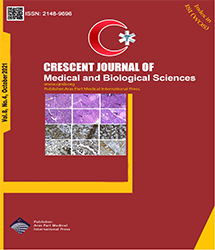
| Original Article | |
| Evaluation of Serum Selenium Levels in Sepsis Patients Hospitalized in Tabriz | |
| Hamid Owaysee Osquee1, Peyman Eini2, Saleh Bahramnezhad1, Mehdi Haghdoost1 | |
| 1Faculty of Medicine, Tabriz University of Medical Sciences, Tabriz, Iran 2School of Medicine, Hamadan University of Medical Sciences, Hamadan, Iran |
|
|
CJMB 2021; 8: 276-282 Viewed : 4991 times Downloaded : 2564 times. Keywords : Severe sepsis, Septic shock, Prediction, Etiology, Selenium |
|
| Full Text(PDF) | Related Articles | |
| Abstract | |
Objectives: Selenium (Se) is one of the elements of the body whose deficiency causes immune system weakness. Given that a weak immune system is one of the main causes of sepsis, in this study, it was decided to increase the serum Se level in sepsis patients in hospitals affiliated to Tabriz University of Medical Sciences. Materials and Methods: In this cross-sectional descriptive study, 82 patients with sepsis (common, severe, and septic shock) were selected using a two-year census sampling ending on March 21, 2019 from Sina and Imam Reza hospitals in Tabriz. Data related to the etiology of the disease, underlying diseases, comorbidities, and inpatient testing were collected for each patient, and serum Se levels were assessed by atomic absorption spectroscopy. To analyze the data, chi-square, t test, and Mann-Whitney U tests were run using SPSS, version 20, and a P value less than 0.05 was considered statistically significant. Results: The results of a review revealed that the history of underlying diseases [diabetes (P = 0.009), hypertension (P=0.019), and malignancies (P = 0.029)], comorbidities [pneumonia (P = 0.001), malignancy and chemotherapy (P = 0.012), and meningitis (P = 0.009)], and disease etiology [bacteremia of uncertain origin (P = 0.001), pneumonia (P = 0.001), urinary tract infection (P = 0.009), and skin infection (P = 0.005)] was significantly higher in patients with septic shock compared to those with sepsis and severe sepsis. On the other hand, the severity of the disease was significantly associated with a decrease in the serum Se level (P = 0.010). Conclusions: In general, serum Se levels decrease with the increased severity of sepsis. Thus, measuring Se levels may be helpful in rejecting the progression of the disease. |
Cite By, Google Scholar
Google Scholar
PubMed
Online Submission System
 CJMB ENDNOTE ® Style
CJMB ENDNOTE ® Style
 Tutorials
Tutorials
 Publication Charge
Medical and Biological Research Center
About Journal
Publication Charge
Medical and Biological Research Center
About Journal
Aras Part Medical International Press Editor-in-Chief
Arash Khaki
Deputy Editor
Zafer Akan


















